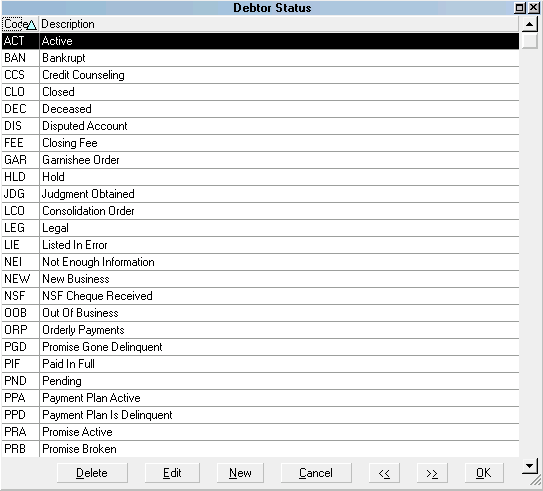Debtor Status Basics
What is a Debtor Status code? A status code is simply a
method to flag the status of an account using your company's
rules for defining the state of an account. A status code can be
a value of up to 4 alphanumeric characters. It can be used in
reports to group, sort, and filter accounts, in your To Do List,
in exporting, and in many other valuable ways, to produce
fast and specific lists of accounts.
 If you are experienced with credit bureau reporting,
do confuse Debtor Status Codes with credit bureau
reporting status codes. These are completely different
and are explained in the credit bureau reporting help.
If you are experienced with credit bureau reporting,
do confuse Debtor Status Codes with credit bureau
reporting status codes. These are completely different
and are explained in the credit bureau reporting help.
Give some thought to the creation of new codes so that
each code serves a distinct purpose. You don't want to
have two or more status codes that basically define
the same account status.
Think about your company policies as accounts move
through your processes. When an account is newly
entered, you may have a status code of NEW to
flag an operator that this is a new account. Once the
operator works the account, you may want to change the
status to ACT to flag that operator work has begun on the
account. Change the status to PTP if the debtor has
agreed to make promise payments. Set the status to NSF
if you have received a returned payment from the debtor.
Then set the status to PIF when the account is paid in full
or set the status to SIF if the account has paid the
settlement amount agreed on. Set a status to SKP if the
account requires skip tracing.
These are just some examples. Every business may
use different codes - a few basic codes, or many codes,
to create a more flexible and efficient method of
working with the accounts.
The Debtor Status Codes list is completely under your
control. Keep the list small. Start simple and add status
codes as you grow, or your needs change. The benefits
will become more obvious as you get more experienced
with Collect!.

Debtor Status Codes
Accessing Debtor Status
The Debtor Status form may be accessed in many ways.
Providing you have access to the various menus and forms,
you can use one of the following ways to get to the
Debtor Status list. When viewing the list of status codes, you
can select one to display the Debtor Status form to modify
any existing status code or description or create a new one.
1. Using the menu bar at the top of Collect! select
System to display the drop-down menu. Select
Contact Management Settings, Status Codes from
this menu and the list of existing status codes will display.
2. Or, you can also gain access to debtor status codes from
the Main Menu. Select the System Administration button to
display the System Setup menu. Select the Setup and Configuration
button to display the System Setup form. Select the Plans and Reference
Tables button to display the Plans, Tables and Defaults form. Finally,
select the Status Codes button and the list of existing status codes
will display.
3. While on a debtor record, you can use the drop-down arrow to the
right of the field labeled STATUS and gain access to the list of
existing status codes.
4. While on any field that has a drop-down arrow which opens a list
of stored contents, if you have the access rights, you will be able
to Delete, Edit or add a New entry into this list.

See Also
- Debtor Status
- Debtor Status Samples

| 
Was this page helpful? Do you have any comments on this document? Can we make it better? If so how may we improve this page.
Please click this link to send us your comments: helpinfo@collect.org